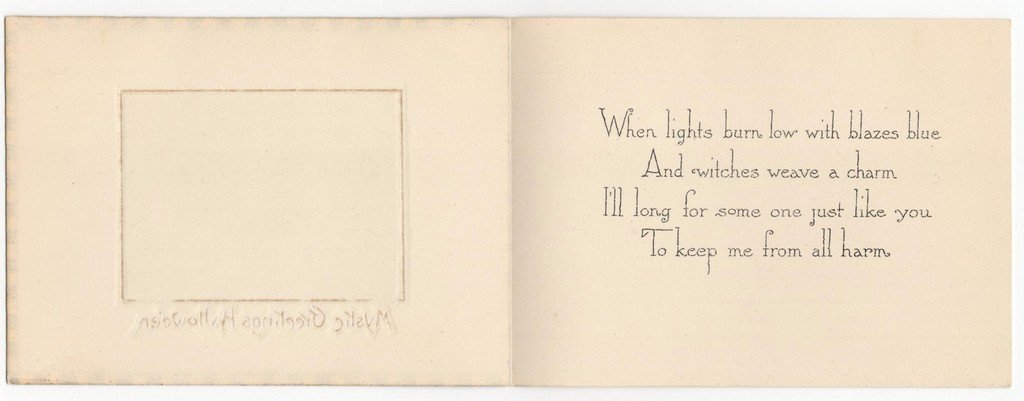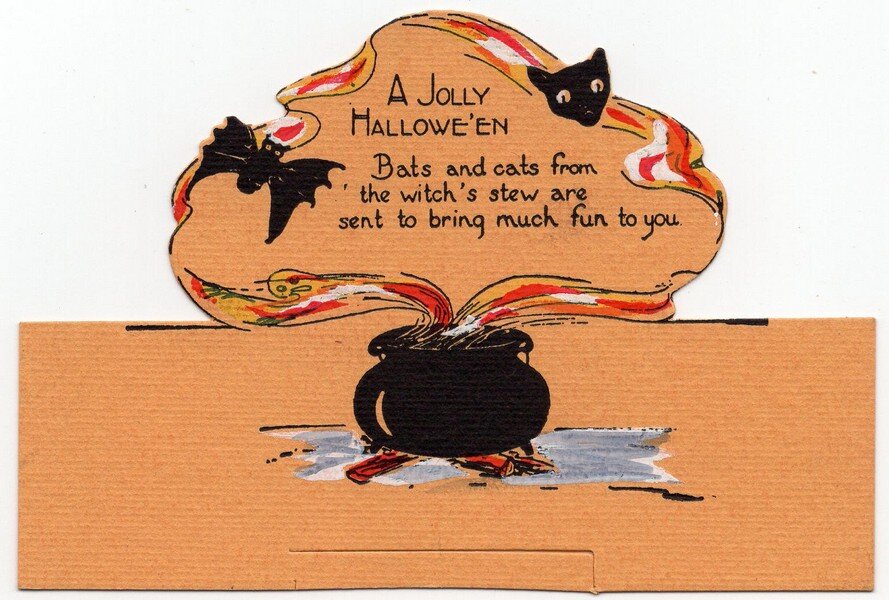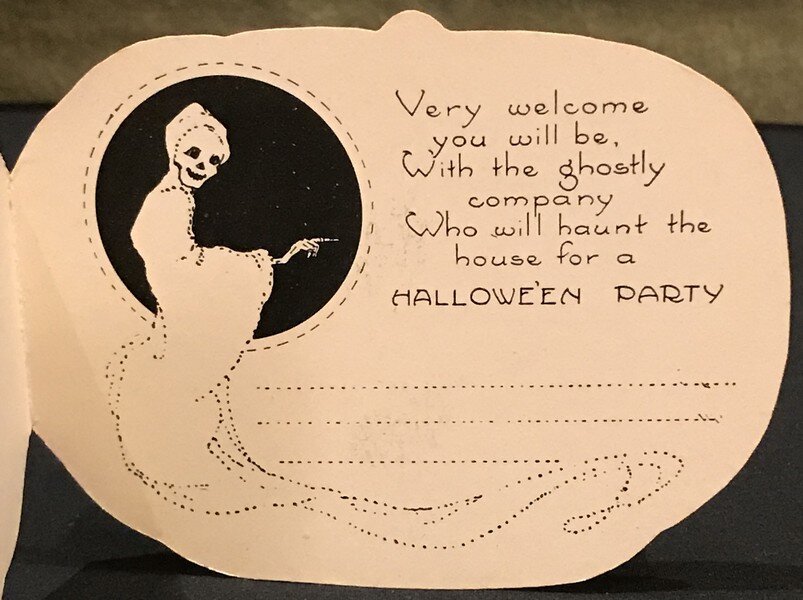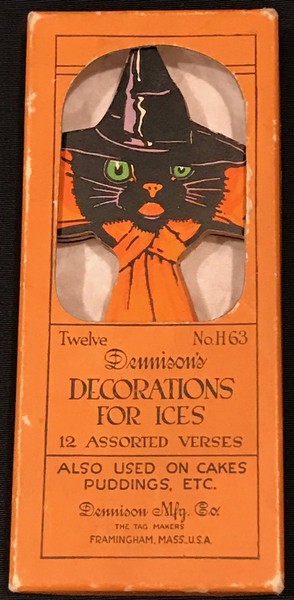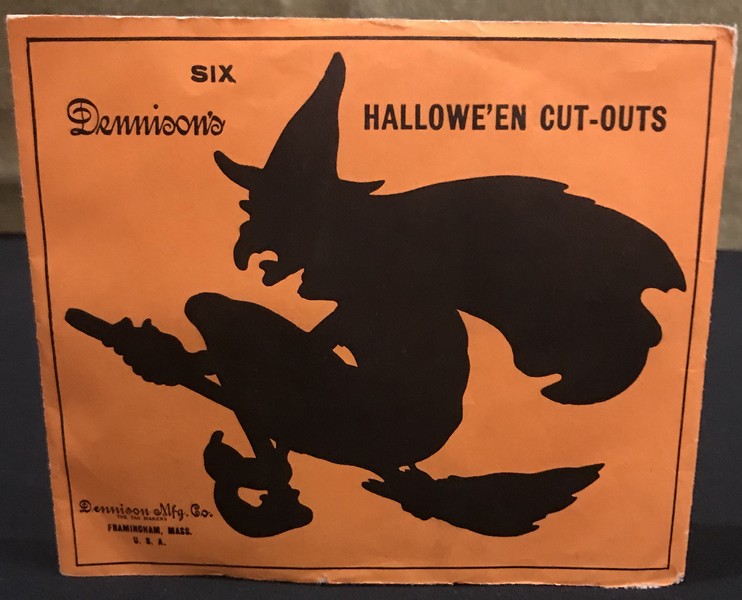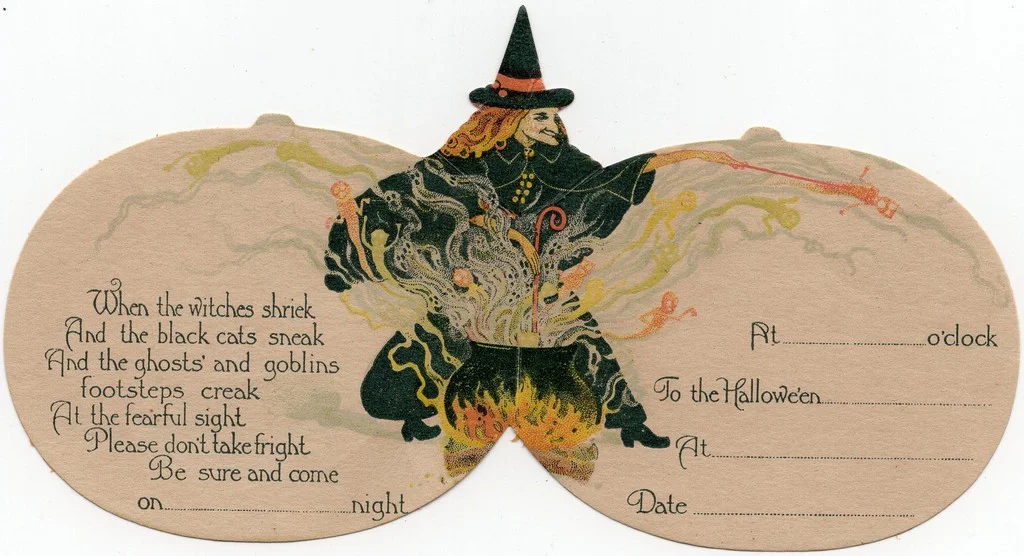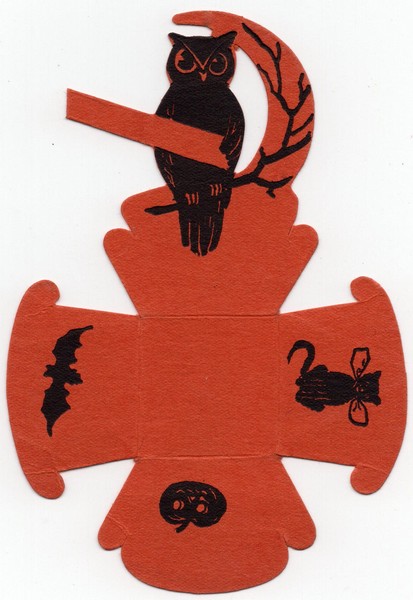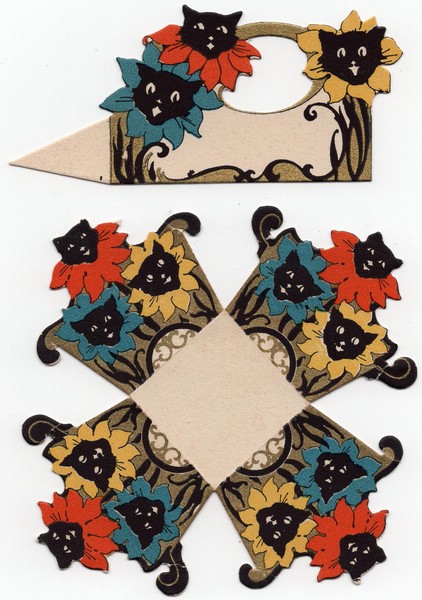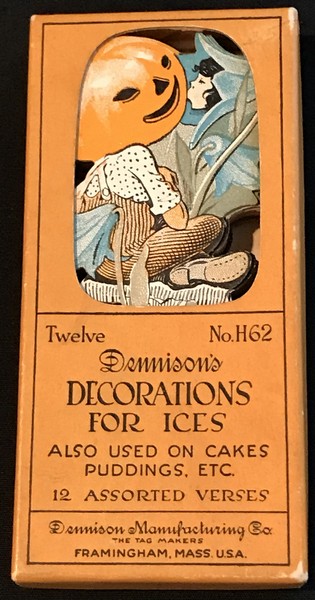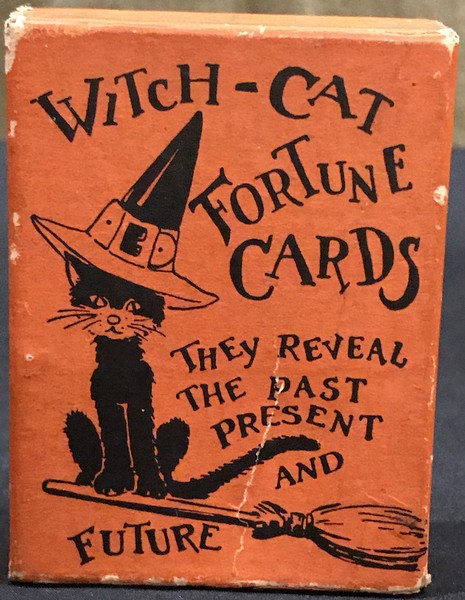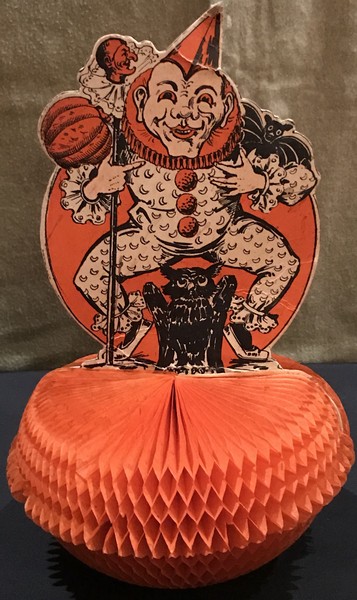Acquisitions
I thought it would be fun for me and informative for you to feature recent acquisitions I have made for the collection. I am using the word “recent” rather loosely as I am going back in my records to acquisitions made since 2014. I plan on showing items that one probably won’t see often, but my picks will surely be eclectic. This is not meant to be an exhaustive listing of all acquisitions, but only pieces that I consider notable and/or fun. I will attempt to add to this aspect of my site regularly, time permitting.
**********************************************************************************
Beistle produced this wondrous folding invitation in 1930, for a single season only. It had a stock number of 837. The original envelope is extant and has a familiar spidery scrawl of a peripatetic traveling salesman. This person was fond of marking envelopes with a short description of the item, the price per gross and the stock number. (I am thrilled whenever I can find something from this mystery employee.) This exceedingly rare invitation measures 7” high by 5.5” across, unfolded. Acquired in September 2019. RSIN: 1
I obtained this unusual and exceedingly rare nut cup in a trade. Even though the condition is far less than my usual collecting threshold, I just like it, so decided to keep it. I don’t know what firm produced this, but they had a design aesthetic I appreciate. It measures 5.5” high by 3.5” across. Acquired in August 2019. RSIN: 1
This invitation is an early one. It has a copyright of 1911. I like the calm yet stark imagery and the JOLs strung along the top, all with differing expressions. It came with its original envelope addressed to a Mrs. Higgins. The invitation measures 2.75” high by 6” across. Acquired in August 2019. RSIN: 1
For those of us who enjoy collecting German diecuts, this is hands-down the Holy Grail of that wonderful market segment. This four-figure fence was one of the designs produced in 1935 and shipped exclusively to Canada. They were shipped folded so every example will have a crease between the second and third figures. Although I had opportunities to acquire this design over the years, I declined to pull the trigger because of various condition issues. Most had lots of missing surface paper, a plethora of pin holes and/or generous dollops of tape still distressingly clinging. When this was offered to me by a long-time collector in Pennsylvania, I jumped. It is the finest of all examples I’ve ever seen. (Sometimes it pays to wait.) Oddly, when I’ve seen this design over the decades, the left-most figure was missing a high percentage of the time. It measures 7.75” high by 27” long. Acquired in April 2019. RSIN: 1
This 3.5” high pulp owl is fairly common yet hotly collected. It was produced by an unknown U.S. manufacturer along with an arched-back black cat with yellow eyes. Both are weirdly difficult to find in near-mint or better condition. Prices remain stickily high even though they surface regularly. (It calls to mind the hard plastic witch-on-motorcycle that is nearly always of offer for $300-400.) Upgraded in February 2019. RSIN: 4
This Mystic Greetings Hallowe’en card was produced in the United States by an unknown manufacturer. It is early, circa 1910, based on the checked border and the eccentric imagery. Did you notice the pensive frog by the footstool? It measures 3.25” high by 4.5” across, closed. Acquired in December 2018. RSIN: 2
This exceedingly rare Dennison door hanger was first produced in 1931 and remained in production for only two seasons. Interestingly, an example sold on eBay in March 2022 for $687. Dennison items from this period have escalated sharply in value in 3.5 years as I acquired the design in December 2018 for $155.49. RSIN: 1
This German composition candy container was produced during the very early 1930s. It stands 7” high and opens from the bottom. Acquired in November 2018. RSIN: 2
This two-toned German composition candy container was produced during the 1920s. I appreciate the unusual coloration and the container’s friendly yet pensive mien. It measures 6” high and opens from the bottom. Acquired in November 2018. RSIN: 1
Beistle had a burst of creativity with diecut designs they first released as early as 1936. This is arguably their best from the batch of diecuts first released that year. It measures 13” high by 10.75” across. Acquired in November 2018. RSIN: 2
Beistle was a master at packaging and repackaging their products to extract the maximum value from existing designs. This envelope of 10 place cards was produced well after the set of 6 shown on page 218. So, although the envelopes differ markedly, the three designs inside each envelope remained static. Interestingly, the distribution of the three designs remained roughly the same. In the set shown on page 218, there are 3 witches, 2 cats and 1 ghost. In the set assigned the stock number of 758 below, the distribution is 6 witches, 3 cats and 1 ghost. These hanging place cards were not sold singly, so the ghost is the scarcest design, by far. Acquired in November 2018. RSIN: 1.
Gibson was known for their large form-factor small paper items like this tally, produced during the 1920s. It measures 5” high x 3.75” across. Acquired in August 2018. RSIN: 2
This exceedingly rare diecut of a black cat pennant was produced in Germany for one season during the interval of 1930-1935. It is one of a set of three. (The book’s caption stating the full set is comprised of four designs was corrected on the errata page some time ago.) This set is, arguably, the most coveted by advanced collectors. This design is by far the most elusive. It measures 15.25” high by 8” across. Acquired in October 2018. RSIN: 1
This exceedingly rare diecut of a JOL-creature pennant was produced in Germany for one season during the interval of 1930-1935. It is one of a set of three. (The book’s caption stating the full set is comprised of four designs was corrected on the errata page some time ago.) This set is, arguably, the most coveted by advanced collectors. It measures 15.25” high by 8.5” across. Acquired in October 2018. RSIN: 1
This exceedingly rare diecut of a devil pennant was produced in Germany for one season during the interval of 1930-1935. It is one of a set of three. (The book’s caption stating the full set is comprised of four designs was corrected on the errata page some time ago.) The variant to this design has the hand and nails all orange. I feel this design is superior. This trio is, arguably, the most coveted set by advanced collectors. It measures 15.25” high by 9.25” across. Acquired in October 2018. RSIN: 1
This exceedingly rare diecut of a banjo player was produced in Germany for one season during the interval of 1930-1935. It is one of a set of three. (The third, playing an accordion, can be seen on page 171.) Of the three, this one is by far, the hardest to find. This measures 15.5” high by 6.5” across. Acquired in October 2018. RSIN: 1
This exceedingly rare diecut of a saxophone player was produced in Germany for one season during the interval of 1930-1935. It is one of a set of three. It measures 15.5” high by 6.5” across. Acquired in October 2018. RSIN: 1
Gibson tried to compete with Dennison in the boxed seal market segment but Gibson was never more than a nuisance competitor in that segment because their design aesthetic was so simple - lacking deep creativity and broad appeal. That said, I love to collect boxes of Gibson seals. They are far less common than almost any set of Dennison boxed seals. This large design of a seated cat was sold in boxes of six. The box measures 4.25” high by 2.5” across. Acquired in October 2018. RSIN: 2
This fortune card was produced by Whitney during the early 1920s as part of a set of at least three. All are exceedingly rare, as I believe production was limited to one season. It measures 3.5” high by 3.5” across, closed. Acquired in October 2018. RSIN: 1
This place card was first produced by Dennison in 1924. It was sold with stock number H-29. It eluded my grasp for too many years. Condition on the ones I saw over time was problematic enough that I would pass, pass and pass again. Finally, this one surfaced on eBay. The well-designed card measures 3” high by 3.5” across. Acquired in October 2018. RSIN: 2
The German porcelain tea set genre is one of my favorite market segments, so when this became available on eBay I knew I had to have it. My wallet opened wide for this classically shaped dual-handled jug. It is marked on the bottom with the German circular mark. This beauty measures 3” high by 3” across. Acquired in September 2018. RSIN: 1
This superbly designed and exceedingly rare invitation was produced by Whitney during the early 1920s as part of a set of three. I believe production was limited to one season. The art work, as you can see, is richly detailed and causes one to speculate about the scene. It measures 3.5” high by 4.25” across, closed. The color registry of the scan is off. The item is actually a matte mellow orange. Acquired in September 2018. RSIN: 1
This diminutive compo JOL candy container was produced in Germany during the 1920s. It measures not quite 2” high. Acquired in August 2018. RSIN: 4
This petite compo figural was produced in Germany during the 1920s. The little girl looks forlorn after braving a heavy downpour! She stands all of 2.5” high. Acquired in August 2018. RSIN: 2
This composition candy container of a witch with a broom in one hand and holding a cat in the other was produced in Germany during the 1920s. It opens at the neck and measures 4.25” high. Acquired in August 2018. RSIN: 2
Isn’t this the most unusual thing? This was originally sold in a souvenir shop for a town now unreadable. Given the shell motif, it was probably a town by a shore. Who dreamed up having a witch head incorporated onto a shell? There is no maker’s mark. A good guess is that this was made during the 1920s. It measures 2.25” high by 3.75” across and 3.75” deep. Acquired in August 2018. RSIN: 1
This set of six figurals was produced in Germany during the early 1930s. All but two were upgrades from identical examples already in the collection. The fellow in yellow with the green tip and the woman in blue were new discoveries and are rarer than the others. Each measures around 2.25” high. The cardboard bases are almost always missing. I bought all at a show in Glendale from a dealer who had them mismarked as Katzenjammer Kids. Acquired in August 2018. RSIN: Ranges from 2 to 4.
This is a combo place and tally card produced by Buzza during the 1920s. The scantily clad cherubic witch rides a broom across a full moon. The item is interestingly made in that the witch folds away from the moon. The tally is on the reverse. It measures 4.5” high by 4” across. Acquired in August 2018. RSIN: 2
This Gibson place card was produced during the late 1920s. It measures 3.5” high by 4” across. Acquired in August 2018. RSIN: 3
Gibson produced this fun tally during the late 1920s. The JOL looks like it has a surprise for the creeping cat. It measures 5” high. Acquired in August 2018. RSIN: 3
I love this large two-piece invitation, produced by Gibson during the 1920s. It measures 4” high by 5.25” across. Acquired in August 2018. RSIN: 2
Dennison had a distinct artistic aesthetic during the very late 1920s and into the early 1930s. This tally exemplifies that aesthetic. Dennison issued a set of these, with designs for each suit. Check out the omnibus suit example on page 260. This superb tally measures 4” high by 2.25” across. Acquired in July 2018. RSIN: 2
This place card was produced by Gibson during the 1920s. What makes this design unusual is that the cat is on a hinge, folding out to give a 3-D effect. It measures 4.5” high by 5” across. Acquired in July 2018. RSIN: 2
This enveloped set of cut-outs was produced by the Hall Brothers between 1923 and 1928 when the name was changed to Hallmark. It was one of their few attempts to make such enveloped sets to compete with their competitor, Dennison. These broomed with cut-outs were sold with the stock number 2314. Each measures 3.25” high by 4” across. Acquired in May 2018. RSIN: 1
This large invitation was made in the U.S.A. during the later 1920s but is otherwise unmarked. It measures 4” high by 5” across. Acquired in May 2018. RSIN: 2
This colorful and rare tally was produced by Hallmark during the later 1920s. It has a stock number of 8631. (Look at those green shoes!) Hallmark small paper items from this period rival in design aesthetic items produced by Dennison. I avidly collect them. This measures 3.5” high by 3” across. Acquired in May 2018. RSIN: 2
I am going to call this a place card given the perforated bottom that would be folded out to allow the card to stand. The graphics are great! The card measures 3.5” high by 5” across. Acquired in March 2018. RSIN: 2
This card was printed in Germany by the J.B. & Co. Inc. of New York during the early 1920s. It measures 2.5” high by 5” across. Acquired in March 2018. RSIN: 1
This exceedingly rare pan clanger was produced by an unknown manufacturer probably during the early 1930s. I have only seen this item once, so it was surely made by a small manufacturer with a limited distribution reach. It measures 8” long by 4” across. It has a green wood ball attached to both sided. Acquired in January 2018. RSIN: 1
This exceedingly rare clanger was produced by an unknown manufacturer during the early 1920s. The graphics are quirky, fun and memorable, especially the running skeleton. It measures 4.5” in diamter. Acquired in October 2017. RSIN: 1
I guess this is supposed to be a demonic clown cat! This diminutive composition candy container was produced in Germany during the 1920s. He stands 3.25” high including the candy box that opens from the bottom. Acquired in October 2017. RSIN: 2
This mint German composition candy container measures 4.25” high. This was purchased from the (becoming legendary) Mabel Brown estate in Geneseo, Illinois. She had purchased many party favors and for some reason packed them all away in trunks, not again to see the light of day until 2017. Seeing this in-person gives me an excellent idea of how wonderful these German-made items were when they were new - and how much care was put into crafting them. Acquired in October 2017. RSIN: 2, but condition makes this a 1
These are two Whitney masterpieces made during the early 1920s. The complete set of these invitations numbers three. (The third one will be shown when I get to that acquisition period.) The artwork is sublime. These are relatively large, measuring 3.25” high by 4.25” across. Given how very rarely they surface, I suspect they were made for a single season. Acquired in October 2017. RSIN: 1
Beistle produced this complete set of four “Hallowe’en Signs” during the 1950s with the stock number of 1899. The idea was to write on the blank spaces to provide information to party invitees. If you look at the final photo you’ll see what I mean. Any of these are exceedingly rare, and to have the opportunity to acquire the whole set at once was fantastic. Prior to their acquisition, I had only owned the witch by the tombstone, and it was heavily marked up. Each measures roughly 12” by 9”. Beistle’s creative apex was well behind them by the later 1950s. This set is quite good, different from much of their output at this time. I feel these were not solid sellers, so the set was almost surely produced for a single season. Acquired in October 2017. RSIN: 1
This large pulp witch carrying a sack into which candy would be placed was produced in the USA in the late 1930s. It is very difficult to find this design in collectible condition. I looked for many years before acquiring this one. It stands 8.25” high and is 5” wide. Acquired in September 2017. RSIN: 2
Gibson produced this mechanical stunt small paper item during the 1920s. It measures 3.5” high by 5.5” across. Acquired in September 2017. RSIN: 2
I love this unmarked energetic invitation. I think it was produced by Rust Craft of Boston, but am unsure since Rust Craft was typically rigorous in marking their items. It measures 3.5” high by 5.5” across. It has pleasing gold highlights and good detail. Even the barrel is marked as a cider barrel. Acquired in September 2017. RSIN: 1
Dennison produced this slide box of twelve arched-back black cat gummed silhouettes outlined in red during the mid-1920s. It measures 3” high. Acquired in September 2017. RSIN: 3
Beistle produced three different witch diecuts as one set during the late 1950s. All are shown on page 159. This measures 18.25” high by 8.25” across. Each is exceedingly difficult to find in reasonably collectible condition. Why? Well, they are large with irregular borders that tend to get bumped, nicked or torn and were made with thin paper stock. It took many years for me to locate one good enough to be in the collection. Each of the three designs is idiosyncratic. I feel the unknown Beistle artist was having fun putting in such features as the worn shoes on this hag. He or she “hid” their initials in the artwork. Can you find them? Acquired in September 2017. RSIN: 2
There was a set of four 3-D cards produced before 1920. Two are shown at the top of page 286. (The complete set is now part of the collection. This one is the same one shown on page 286. I happily acquired both on that page from their very good caretakers!) Postcards with this same artwork were made contemporaneously with these stand-up 3-D cards. The eight individual postcards were combined to make the four 3-D cards. These postcards were published by Bergman as series 6070 and 6071. Each of the 3-D card designs is exceedingly rare. Acquired in September 2017. RSIN: 1
I avidly collect every Rosen Halloween paper item I can find. That firm made wonderful mechanical items like the boxes you can see on pages 116-118, plus the now hard-to-find candy purse on page 52. When I saw this offered on eBay, I knew I had to have it. Both sides have identical imagery and the sides of the box itself are nicely designed. This measures 2.75” high by 2.25” across by 1.5” deep. Acquired in September 2017. RSIN: 1
Glasses the better to see you with, my dear! This superb JOL-headed witch candy container was produced in Germany during the 1920s. The molding is nicely detailed. It opens at the neck and stands 5” high. The broom is original. Acquired in September 2017. RSIN: 2
This pensive composition boy figural was produced in Germany during the 1920s. He stands 4.75” high including the candy box that opens from the bottom. Acquired in September 2017. RSIN: 2
I’m not sure if he is meant to be a baseball player or what, but this composition candy container was produced in Germany during the early 1920s. He stands 3.5” high and opens at the neck. Acquired in September 2017. RSIN: 2
This composition candy container was produced in Germany during the early 1920s. This Veggie girl in a white outfit with a green leaf collar opens at the neck and stands 3.75” high. Acquired in September 2017. RSIN: 3
This composition candy container was produced in Germany during the early 1920s. This Veggie girl in a white outfit with a green leaf collar opens at the neck and stands 3” high. Acquired in September 2017. RSIN: 3
This little composition figural was produced in Germany during the early 1920s. He stands all of 3” high including the candy box that opens from the bottom. Acquired in September 2017. RSIN: 3
This is an exceedingly rare variant of the simple waste bowl with face from the German porcelain set made from 1908-1932. It has what I call a bubbly bottom. It measures not even 1.25” high by 2.25” across. Acquired in August 2017. RSIN: 1
Beistle began producing their successful Johnny Pumpkin Head line in 1919. This exceedingly rare envelope for an assortment of six was made then. This wonderful ephemeral item measures 10” high by 7” across. Acquired in July 2017. RSIN: 1
Isn’t this a great tally? It is another great Gibson design. I appreciate its Art Deco feel. It measures 4.25” high by 3” across. Acquired in July 2017. RSIN: 2
I believe this smartly designed invitation was produced by Gibson - mainly due to the slanted exclamation point. The art is simple but effective with its whimsical font. It measures 3.5” high by 3.25” across, closed. Acquired in July 2017. RSIN: 1
This very large and imposing tally was produced by Gibson during the 1920s. Given the irregularity of its borders it is almost never seen in near-pristine condition. It measures 6” high by 2.75” across. Acquired in July 2017. RSIN: 2
This spectacular lantern is exceedingly rare and desirable. This was made just prior to 1920, pretty early in terms of German production that ended in 1935. One of the early and influential collectors of vintage Halloween was a kind, well-informed man with an excellent eye for quality, Hugh Luck. Hugh decided to sell the bulk of his curated and splendid collection in 1997 through Dunbar’s Gallery, in two separate auctions. I eagerly paged through the catalog (now so primitive looking…) marking the items I wanted in three tiers. The “A” tier was comprised of the items I wanted the most. I basically bought the heart and soul of this collection missing out only on two items from my “A” list - a devil head candy container and a pumpkin blossom lantern like this one. The devil candy container sold for $3,801 and the pumpkin blossom lantern sold for $3,850. (Remember, this was back in 1997!) I’ve seen many equally beautiful devil head candy containers in the 22 years since, so was happy I wasn’t the prevailing bidder then. However, I had never seen another pumpkin blossom lantern. The fact that I missed out on it bothered me over the years.
Now, skip ahead to June 2017. Close friends of mine who also collect vintage Halloween items acquired two of these lanterns from one seller, both in pristine condition - significantly better than the one from 1997. They kept one and traded me the other. It is one of the many true prides of my personal collection - on display front and center in a large display cabinet. It measures 4.75” high by 3.5” across the bottom. Acquired in June 2017. RSIN: 1.
This nut cup was made by an unknown manufacturer during the 1920s. The blue works so well with the yellow. I appreciate the simple imagery. I hadn’t seen this item prior to its acquisition, nor have I seen it since. It measures 6” high by 3.75” across, unfolded. Acquired in June 2017. RSIN: 1
This is an exceedingly rare novelty place card. The art is similar to that used in the invitation showing a courtroom presided over by an owl judge. (You can find this item, acquired in March 2017, below.) When you hold the “mirror” up to a strong light, a sour schoolmarm’s image will appear. This may have been made by Whitney. It measures 3.5” high by 6” across. Acquired in June 2017. RSIN: 1
I like the serenity of this owl place card. Made during the 1920s by an unknown manufacturer, it measures only 2” high by 4.5” across. Acquired in June 2017. RSIN: 2
This unusual place card was produced by Gibson sometime during the 1920s. (It is marked on the reverse.) It measures 3.75” high by 3.25” across. Acquired in June 2017. RSIN: 3
This is one of the German diecuts that were made for a single season in 1935 and sold only in Canada. It is a mechanical in that the cat lifts off of the JOL. (A black cardboard flat piece attached to the cat fits in the slot at the top of the JOL.) This measures 9.25” high by 6” across. Acquired in May 2017. RSIN: 1
This grim devil was produced by Beistle during the mid-1920s. This non-embossed, jointed diecut measures 17” high. There is a variant that has a tail. It is shown on page 126. Acquired in May 2017. RSIN: 1
This slide box of 25 Dennison seals was produced during the late 1920s. That is an owl along for the ride. Acquired in May 2017. RSIN: 2
This is one of the German diecuts that were made for a single season in 1935 and sold only in Canada. There are four known examples to this set. Two others are shown on page 130. The third shows a skeleton playing a saxophone with a cat looking up and a JOL in the background. The violin-playing Mr. Bones measures 15” high by 7” wide. Acquired in May 2017. RSIN: 1
This exceedingly rare diecut was made by an unknown manufacturer in the later 1920s. It is quite large, measuring 20” high by 19” across. It is non-embossed. Prior to its acquisition, I had never seen it before, nor have I seen another example since. There is a possibility it was made by Dennison. Acquired in May 2017. RSIN: 1
Dennison issued this boxed set of twelve Hallowe’en Cut-Outs with this stock number of H56 for two years only, 1921 and 1922. For 1923 and 1924, the same cut-outs but with twelve new fortunes were issued as a boxed set with stock number H60. IN 1925, the stock number was again changed to H65 for some reason. Acquired in May 2017. RSIN: 3
Dennison issued this box of twelve Decorations For Ices ~1924 with a stock number of H63. The box measures 3.75” high by 1.75” across. Acquired in May 2017. RSIN: 2
This charming flip-open tally was produced by an unknown manufacturer during the 1920s. It has a stock number of HT203. It measures 3” high by 3” across, closed. Acquired in May 2017. RSIN: 3
Hallmark made a wide array of Halloween small paper goods beginning in the mid-1920s. Their items have finally begun coming into their own. Long eclipsed by Dennison, Beistle and Gibson, Hallmark’s subtle use of color and grounded design sensibility has easily stood the test of nearly 100 years. I have become an avid collector of their items from this time period. This whimsically busy tally card was produced during the later 1920s and has a stock number of H78. It measures 5” high by 4” across. Acquired in May 2017. RSIN: 1
Hallmark made a wide array of Halloween small paper goods beginning in the mid-1920s. Their items have finally begun coming into their own. Long eclipsed by Dennison, Beistle and Gibson, Hallmark’s subtle use of color and grounded design sensibility has easily stood the test of nearly 100 years. I have become an avid collector of their items from this time period. This harlequin invitation was produced during the later 1920s and has a stock number of H20. It measures 3” high by 5” across. Acquired in May 2017. RSIN: 2
This is one of the gems of the small paper collection. Beginning in 1929 when this was produced, Dennison was hard hit by the Great Depression, as were so many other firms making non-essential items. They responded by making fewer holiday items in fewer numbers - and lived to tell about it. (Dennison is still in business today, albeit through mergers.) Prior to acquiring this invitation I had never seen it before. I know of one other in a collection. It is unused. When opened, there are partial pine trees at the left and the right, with a lined area where a party host would delineate the party details. It measures 4” high by 3.5” across, closed. Acquired in April 2017. RSIN: 1
Whitney pushed the envelopes on many of their small paper designs, often producing complicated ephemeral items. They produced a set of three pumpkin car invitations during the early 1920s. (The third one has a cat driver. I own it and will scan it when I get to the entries as to when it was acquired.) I finally was able to acquire these two in acceptable condition. Although they surface from time to time, the condition is typically quite ragged due to the how the invitation was made to hold together. Each measures 3.25” high by 4.5” across, closed. Acquired in April 2017. RSIN: 1
Whitney produced these “rub-a-dub-dub - three cats in a pumpkin tub” invitations sometime during the 1920s. Whether additional designs comprise a set is unknown. Each measures 3.75” high by 3.25” across. Acquired in April 2017. RSIN: 3
These bizarre place cards were printed in Germany prior to 1920 and feature the artwork of the prolific yet mysterious H.B. Griggs. (So little is known of Griggs that whether Griggs was male or female is disputed.) Each measures 2.25” high by 4” across. Acquired in April 2017. RSIN: 1
Beistle issued many of their products in both enveloped and boxed sets. Generally, these are otherwise identical. For example, the set shown on page 221 with a stock number of 575 is otherwise identical to the enveloped set issued with stock number 574. These aforementioned sets are often seen, and have an RSIN of 4. Here’s a curve ball: The set shown below has the same stock number of 574 and the same cover imagery, but the contents are different: 15 sheets containing 30 silhouettes. I have seen this iteration only a handful of times in 31 years of collecting. When you are out and about searching for vintage Halloween, keep this subtle difference in mind. Don’t pass up a rare variant like this thinking you already have it. Acquired in April 2017. RSIN: 1
Beistle produced an amazing number of Hallowe’en Party Helps enveloped sets during the 1920s. I still find examples I haven’t seen before, like this nifty set. I’ve long admired Beistle’s ingenuity in wringing out efficiencies in their product line by adapting existing artwork for new purposes. This design was first used in ultra-rare large enveloped sets like those seen on page 147. They significantly shrunk the size down for this set issued with stock number 1011. It measures 5” high by 4” across. Acquired in April 2017. RSIN: 2
Dennison produced this enveloped set of six broomed witch silhouettes sometime during the very early 1920s. It measures 4.5” high by 5.25” across. Acquired in April 2017. RSIN: 4
Dennison issued this slide box of six “dazed and confused” cat cut-outs in 1923 with a stock number of H-91. The box measures 5” high by 3.25” across. Acquired in April 2017. RSIN: 2
This is a two-piece tally produced by Gibson during the early 1920s. It measures 5” high by 2” across. Acquired in April 2017. RSIN: 3
Gibson made comparatively few enveloped sets of their products, so I was pleased to acquire this rarity from the early teens. The envelope measures 3” high by 3.5” across and contains the designated JOL shape in a thin yet rigid cardboard stock. Acquired in April 2017. RSIN: 1
Here is a much sought-after pop-up invitation. This first appeared in Dennison’s 1917 Bogie Book. They assigned a stock number of H30 to it. It measures 4” high by 7.25” across, opened. Acquired in March 2017. RSIN: 2
This is another much sought-after pop-up invitation. It was almost certainly made by Whitney during the 1920s. It is intricately designed and quite fragile. I can’t imagine many have survived nearly 100 years with as little damage as this example. It measures 4.75” high by 8” across, opened. Acquired in March 2017. RSIN: 1
I think this exquisitely designed invitation was produced by Whitney, although I am not sure. The envelope in which this was mailed is extant and bears a 1924 postmark. I’ve seen only a handful of these over three decades and all were missing the “A Halloween Subpoena.” When unfolded, there are indicated lines for "place," "date," and "hour." It measures 4.5” high by 3.5” across. Acquired in March 2017. RSIN: 1
This simple nut cup was made by an unknown manufacturer sometime during the 1920s. It also doubles as a place card. It measures 5.5” high by 4” across, unfolded. Acquired in March 2017. RSIN: 2
This simple nut cup was made by an unknown manufacturer sometime during the 1920s. It also doubles as a place card. It measures 5.5” high by 4” across, unfolded. Acquired in March 2017. RSIN: 2
I love these two tallies, part of a set by an unknown manufacturer, a manufacturer which had the budget for skilled artists. The better of the two is on the right. Just look at the specter rising from the cauldron around which caper small witches. Each measures 5” high by 2” across. Acquired in March 2017. RSIN: 2
This tally of battling cats on a rickety picket fence against a harvest moon was made by Gibson during the 1920s. I like the dyspeptic JOL. This is a large item measuring 4.25” high by nearly 4” across. Acquired in March 2017. RSIN:2
This tally was produced by the Charles S. Clark Company of New York during the 1920s. It measures 5” high by 2.25” across. Acquired in March 2017. RSIN: 3
Oval-shaped small paper items are uncommon. This understated two-piece tally was made by an unknown manufacturer during the 1920s. It measures 5” high by 2.25” across. Acquired in March 2017. RSIN: 3
All of these non-embossed small diecuts were produced by Hallmark during the 1930s. They range in height from 4-5”. Acquired in March 2017. RSIN: This varies, but generally 2.
Hallmark issued this simple tally card during the 1930s. It is marked and provides a big clue to the maker of a set of non-embossed small diecuts, most with an orange border. I thought for years these small diecuts were made by Whitney, but given that this tally’s cat design is identical to one of the small diecuts (See the items directly above…), it is logical to assume that Hallmark was the maker, not Whitney. (So, the two small diecuts at the middle of page 164 are now believed to be made by Hallmark, not Whitney.) This is a two-piece tally measuring 5” high by 2” across. Acquired in March 2017. RSIN: 3
Over the years I’ve come to appreciate and covet items made by Gibson, like these two wonderful pieces to a 1920s set. (Typically, the larger paper manufacturers would issue themed sets comprised of an invitation, a nut cup, a tally card and a place card. You can see the tally card on page 270.) I like the dreamy quality of these cat-face flowers. Both designs were done by a top-flight artist. The place card measures 1.75” high by 3.75” across. The nut cup measures 4.5” across, unfolded. (If I buy a nut cup folded, it stays that way and vice-versa.) Acquired in March 2017. RSIN: 2
This simple invitation was surely issued by a regional firm with a small art design budget during the 1920s. It measures 2.5” high by 5” across. Acquired in March 2017. RSIN: 2
This place card shows two kids atop a pumpkin that looks like it was picked some time ago! There isn’t a maker’s mark, but a stock number of SKH.13 on the reverse. It was made in the USA sometime during the 1920s. It measures 3.25” high by 5.5” across. Acquired in March 2017. RSIN: 4
There is sure as lot going on in this small 1920s place card. I love the level of detail this unknown artist invested in this ephemeral item. The only mark on it indicates that it was made in the USA. It measures 1.75” high by 4.5” across. Acquired in March 2017. RSIN: 2
This invitation is one of the best in the entire collection. The level of detail present in this item made by an unknown manufacturer is amazing. Look at the treeline behind the brick wall. Notice that each JOL is different. Even the graining of the gates is done with care. It is dated 1919 by the party host. It measures 2.75” high by 4” across, closed. Acquired in March 2017. RSIN: 1
This is an exquisitely designed piece of ephemera. It is a booklet containing two menus for Gimbel’s Tea Room on the occasion of their 4th anniversary in 1908. The booklet measures 5” high by 3.5” across, closed. As you will surely agree, the imagery is fantastic. Acquired in March 2017. RSIN: 1
This large invitation was produced by Masters under their Unique Line label during the 1920s. It measures 4” high by 5” across. There were matching tally and place cards produced to round out a three part set. Acquired in March 2017. RSIN: 2
These two German compo Veggie figurals stand 2.5” high (left) and 2.75” high (right). Produced quite cheaply in Germany during the late 1920s through the early 1930s, few have survived on their original cardboard discs. Acquired in March 2017. RSIN: 3
Beistle issued this boxed set of their Hallowe’en Pumpkin Fortune Game in 1931 with a stock number of 877. On page 17 you can see their otherwise identical enveloped set they issued with stock number 874. The box measures 7.25” high by 5.75” across. Acquired in March 2017. RSIN: 2
There was a set of four 3-D cards produced before 1920. Two are shown at the top of page 286. (The complete set is now part of the collection.) Postcards with this same artwork were made contemporaneously with these stand-up 3-D cards. The eight individual postcards were combined to make the four 3-D cards. These postcards were published by Bergman as series 6070 and 6071. Each of the 3-D card designs is exceedingly rare. It measures 3.5” high by 6.75” across, open. I love the JOL lanterns. Acquired in March 2017. RSIN: 1
There was a set of four 3-D cards produced before 1920. Two are shown at the top of page 286. (The complete set is now part of the collection.) Postcards with this same artwork were made contemporaneously with these stand-up 3-D cards. The eight individual postcards were combined to make the four 3-D cards. These postcards were published by Bergman as series 6070 and 6071. Each of the 3-D card designs is exceedingly rare. It measures 3.5” high by 6.75” across, open. The cat is missing its tail and the tip is off the owl’s wing. Acquired in March 2017. RSIN: 1
Hallmark was an insignificant player in the boxed Halloween seals market segment compared to Dennison, Gibson and even Whitney. I don’t know if there were more than a handful of designs produced. Unfortunately, their seal designs are pedestrian - and even forgettable. That includes this boxed set of 15 seals produced under the Hall Brothers, Inc. moniker, dating it from the period 1923-1928. It measures 2.25” high by 2” across. Acquired in March 2017. RSIN: 2
This complete box of Dennison Decorations for Ices was first produced ~1923. Each (JOL-headed child being kissed by a flower fairy) has a verse on the reverse. Acquired in March 2017. RSIN: 2
This clanger is surprisingly difficult to locate. It was produced by T. Cohn during the 1940s. The colors and relative complexity of design differentiate this from much of T. Cohn’s other items. It measures 4” in diameter. The image shows three cats, two JOLs, four bats and four ghosts all on or above a white fence. Acquired in February 2017. RSIN: 2
This tiny box of seals was produced by Whitney during the 1920s, probably earlier in the decade than later. Whitney didn’t produce a great variety of boxed seals and the like, effectively ceding those segments of the market to their much better capitalized competitor, Dennison. The box measures only 1.25” square. There is no label indicating the quantity of seals the box should hold, a common shortcoming of Whitney. Acquired in February 2017. RSIN: 2
This exceedingly rare German diecut of a seated black cat wearing a red bow was produced during the early-to-mid-1930s. It uses a hinged body similar to the crawling baby diecuts shown on page 169. I like its direct, unwavering gaze. The diecut measures 9” high by 5” across. Acquired in November 2016. RSIN: 1
This is an exceedingly rare German mini-diecut of a seated cat that is almost certainly meant to be part of the set shown on page 185, middle right. The Germans designed a number of diecuts that had limited distribution in the early-to-mid-1930s. These examples are all exceedingly rare and quite coveted. This is such an example. It stands 5” high and is 2.75” across. Acquired in October 2016. RSIN: 1
This exceedingly rare German mini-diecut is shown on page 171. My good friend, Jason Walcott, was kind enough to let me photograph the example in his collection, but I was able to acquire my own after publication. The Germans designed a number of diecuts that had limited distribution in the early-to-mid-1930s. These examples are all exceedingly rare and quite coveted. This is such an example. It stands 5” high and is 2.75” across. Acquired in October 2016. RSIN: 1
Here is the second of two iterations of a simple crescent moon gummed decoration Dennison first issued in 1921. Both the box of black crescents shown on page 248 and this box of orange crescents were sold with stock number 13. The box measures 2” square. Acquired in September 2016. RSIN: 2
I believe this combo place card and fortune was produced by Hallmark during the later 1920s. The Hallmark attribution is tentative. One of their design choices seems to have been to leave an orange border around black artwork, leading me to make this attribution. Secondly, all of the other items bought from the private seller at this time were made by Hallmark. The lid of the cauldron lifts off to reveal a fortune. It reads, “Good Fortune will continue To richly bless you Not only at Hallowe’en But all life through.” Nothing sinister there - so Hallmark! It measures 4” high by 3” across. Acquired in September 2016. RSIN: 2
Hallmark made a wide array of Halloween small paper goods beginning in the mid-1920s. Their items have finally begun coming into their own. Long eclipsed by Dennison, Beistle and Gibson, Hallmark’s subtle use of color and grounded design sensibility has easily stood the test of nearly 100 years. I have become an avid collector of their items from this time period. This owl tally was made during the later 1920s. It measures 3.75” high. Acquired in September 2016. RSIN: 2
I like the unusual imagery and coloration of this tally. It appears the child has been startled awake and is now beset by ominous bats. The combination of whimsy and danger is compelling. The two-piece tally was printed by Buzza with a stock number of T-277. It measures 5.25” high. Acquired in September 2016. RSIN: 2
This cute wrap-around cover protects the thick pad of bridge scoring pages inside. Hallmark produced this item during the later 1920s. It measures 5” high by 3.5” across. Acquired in September 2016. RSIN: 2
This is an exceedingly rare invitation that Dennison produced around 1930. The inside font is one I haven’t seen before with Dennison items. The paw of the fully visible cat fits into a groove above the obscured head of the second cat. This rare delight measures 2.75” high by 4” across (closed). Acquired in August 2016. RSIN: 2
This is one of the harder-to-find variants of the JOL series issued by Beistle with their H.E. Luhrs’ copyright. It measures 6.5” high by 8.5” across. Acquired in June 2016. RSIN: 3
I’m not sure which firm produced this interesting set of 24 boxed fortune cards. The cover art is reminiscent of Whitney, but the interior art isn’t. The interior art and the semi-glossy card stock used is quite similar to the contents of the Pumpkin Fortunes game shown on page 23 at the middle right. I suspect both were made by the same unknown firm. This game includes instructions. The box measures 3” high by 2.5” across. Acquired in July 2016. RSIN: 1
This box of 6 Dennison cut-outs represents a variant to the box shown on page 251 at the upper right. Although the contents are identical, this box lacks a printed stock number and has the shading characteristic of products issued in the later 1920s. It measures 4” square. Acquired in March 2016. RSIN: 4
This 1929-1931 box of seals was issued by Dennison. This design is exceedingly rare, leading me to think their overall production run was tapering off due to the Great Recession at the time. Prior to purchasing this I hadn’t seen it before. It measures 2.75” high by 2” across. Acquired in February 2016. RSIN:1
This exceedingly rare fortune game was produced by Gibson during the early 1930s. Each of the 12 black feathers can be removed to reveal an individual fortune. (One fortune reads, “You ought to become a Sugar Planter. You raise “Cain” so easily.”) Each fortune is numbered to correspond with its numbered slot. This game is sizable, measuring 13.5” high by 14.25” across. Acquired in February 2016. RSIN: 1
This diminutive box of cat head seals was produced by Gibson during the 1920s. There are 20 seals to the box, which measures only 1.25” square. Acquired in January 2016. RSIN: 2
This pristine box of Dennison silhouettes represents their very first boxed silhouette design. Other than the one time, I’ve not ever seen this before. (I bought this at a show called Alameda Point for $5!) It measures 2.75” high by 3.5” across by not quite half an inch deep. It dates to the early teens. Acquired in October 2015. RSIN: 1
These very well designed nut cups (never folded) were produced by Whitney during the 1920s. Just look at the level of detail and imagination poured in to these wonderful items. There is at least one more to the set I’ve not yet managed to acquire. Acquired in November 2015. RSIN: 2
This German diecut is a variant of the owl shown on page 180, middle middle. It measures 7.5” high rather than 7”. There are other differences as well in the feathering and the shoulders. Acquired in October 2015. RSIN: 2
This large, colorful nut cup was produced during the 1920s by an unknown manufacturer. Some elements lead me to think it is a Gibson product, while others lead me to believe it is a Whitney product. (I sure do wish more things were marked!) What I do know is that it is awesome! I appreciate the shades of green and orange used and the jauntiness of the cats. The seemingly winking witch is either meant to be coquettishly alluring or something else altogether. This item doesn’t appear to have ever been folded. Unfolded, it measures ~7.25” high by 5” across. Acquired in October 2015. RSIN: 1
Here is a Dennison publication that was acquired the one and only time I’ve seen it. It provides party decorating ideas using Dennison items. It is a pamphlet that folds out to show many detailed illustrations. Folded, it measures ~8.5” high by 5.5” wide. This is Dennison publication #105. It was printed in 1930. Acquired in October 2015. RSIN: 1
This exceedingly rare German diecut was surely one of the 1935 designs sold to Canada. Prior to its acquisition, I had never seen it before. This white-haired witch with glasses has her familiar to one side and a fierce-looking crow atop her hat. The diecut is comprised of two pieces. One section is the witch’s bottom half and the cat. It fits in to the main section, enabling the piece to stand. The diecut measures ~9.25” high by 6” across. Acquired in September 2015. RSIN: 1
This large and stunning invitation was produced by Hallmark during the early 1930s. It measures ~3.75” high by 5.75” across. I’ve developed quite an appreciation for Hallmark Halloween paper from this period. Their peppy designs and subtle use of color are compelling. The following little touches in this miniature work of art make it superb: the owl’s umbrella, the pipe-smoking JOL and the cat’s disproportionately enormous tail. Acquired in September 2015. RSIN: 1
This stunning tally card was produced by Masters as part of their Unique Line during the early 1920s. They were a regional manufacturer with limited marketing and distribution. Original production runs were surely small, with survivors to the present day minuscule. It looks to be hand-tinted. It measures ~3.25” square. Acquired in September 2015. RSIN: 1
This stunning tally card was produced by Masters as part of their Unique Line during the early 1920s. They were a regional manufacturer with limited marketing and distribution. Original production runs were surely small, with survivors to the present day minuscule. It looks to be hand-tinted. It measures ~3.25” square. Acquired in September 2015. RSIN: 1
This simple invitation was produced by an unknown manufacturer during the 1920s. I love the witch’s green highlights. It measures ~2.75” high by 4.25” across. Acquired in September 2015. RSIN: 3
This pleasing place card showing a JOL-headed witch ambling along was produced by Gibson during the 1920s. It stands ~3.75” high. Acquired in September 2015. RSIN: 2
This simple tally card was produced by Dennison during the early 1930s. The top of the actual tally is the black tail, so it is another ingenious Dennison design. It measures ~6” high. Acquired in September 2015. RSIN: 2
This is one of the large roly-poly designs that Beistle produced in 1930. (You can see two others on pages 226-227.) As with the others, the reverse shows a rear view. The table decoration stands ~11” high by ~6” in diameter. There are four to the complete set. Acquired in September 2015. RSIN:1
Of the at-least-six diecuts with transparencies that Beistle released during the late 1940s, this one is by far the most elusive. This JOL diecut measures ~8.75” high by 6” across. I like it much better than the rather dopey design of a JOL wearing a polka-dotted bow-tie and tiny cocked hat that you can see on page 155. Acquired in September 2015. RSIN: 1
This pulp JOL nut cup with a choirboy mouth is much harder to find than the one shown on page 294, lower left. It measures the same at ~2.5” high, but has a somewhat more sophisticated molding. I feel it was produced in the later 1950s. Acquired in September 2015. RSIN: 3
This may be the most graphically interesting boxed candle set made. The lid is a deep blue that is quite arresting. (Unfortunately, the color saturation doesn’t translate well with my camera!) The imagery is simple yet effective. The box holds twenty thin orange candles and measures ~4” square. The set was produced during the 1920s. Acquired in September 2015. RSIN: 2
This is a complete, mint set of mechanical nut cups produced by Beistle for only a single season - 1938. (You can see folded examples on pages 223-224.) These are made from thin, flat stock paper and are quite delicate. I can hardly believe these have survived in such pristine condition! I acquired four complete sets in April of 2015. I kept the best set. Another was sold to close collecting friends, one was sold in my May 2015 auction and the last set was pieced out. In the purchased lot there were also a number of singles in fair to good condition. These came out of Massachusetts. Beistle recycled art from their roly-poly set for these nut cups, adding a different mechanical feature for each. (The true, very dark orange coloration of the set did not come through in this photograph! For some inexplicable reason, they look washed out.) Acquired in May 2015. RSIN: 1
Beistle produced a handful of enveloped products during the later 1920s with a cellophane center. This seems to have been a short-lived experiment. (A stunt game example can be seen on page 17.) This is a complete set of place cards. Printed at the bottom of the envelope is: 6 Place Cards - The Fronts are Movable. It has a stock number of 657. I have never seen another set of these so am unsure if the distribution of one witch, two ghouls and three owls was standard or if there were variations. (Given the rather primitive specs existing at the time, I suspect there was not a standard set of contents.) Acquired in February 2015. RSIN: 2
Although this isn’t much to look at, the Price List pamphlets Dennison issued annually are a wealth of information. If you are able to piece together an unbroken run, it is easy to discern when Dennison began producing a certain item and when they ceased production. Savvy collectors who are interested in curating their collection snap these up when they infrequently appear on the market. Acquired in June 2015. RSIN: 2
This flapper or Betty Boop diecut was produced in Germany during the 1920s. It is heavily embossed and measures ~9.5” high by 11.25” across. On page 183 you can see similarly sized examples looking both down and to the left. Acquired in June 2015. RSIN: 4
This jumbo diecut was issued by Beistle off and on from 1957 through 1962. All items from this set were over-sized. If you look on page 160, you will see a scarecrow diecut that is another item from the small set. This measures ~14.75” high by 15.75” across. Acquired in November 2014. RSIN: 2
This very large diecut is one of the earliest Beistle produced. It was marketed as a “hanger.” This is one of two designs, the other being a broomed witch atop a JOL. (The JOLs are identical to one another.) They were sold to retailers in packages of two dozen per package. It measures ~15” high by 9” across. It is printed on one side only. These were produced starting in about 1919 and surely weren’t produced for more than a few seasons. Acquired in December 2014. RSIN:1
This jumbo diecut was issued by Beistle off and on from 1957 through 1962. All items from this set were over-sized. If you look on page 160, you will see a scarecrow diecut that is another item from the small set. This measures ~25” high by 10.5” across. Acquired in June 2017. RSIN: 2
You surely have noticed that I identify some Dennison items as being sold singly rather than in enveloped or boxed sets. This is a great example of how such items would have been sold to the end-consumer by a retailer. If you went into your local stationer during the early 1920s looking for this place card of a broomed witch in the clouds by a crescent moon, you would buy as few as one, taking your item from the decorative box shown. These decorative boxes are exceedingly rare and VERY desirable to Dennison collectors. The box measures ~5.25” high by 7” wide by .75” deep and would hold 25 place cards in each well. This box is from 1924. Acquired in February 2014. RSIN: 1
This party sign diecut was produced by Whitney during the 1930s. It is one of a set of four. Two others can be seen on page 163. Two had owls at the top of the sign, two had cats. Except for the signs’ messages, the two of each are identical to one another. The one missing from the collection has cats along the top with the message, “Where Spirits Roam.” The latter sign sold on eBay in October of 2018 for an unsustainable price of $520.10. (I was the exceptionally unhappy underbidder.) The sign measures ~7.75” high by 14.25” across. Acquired in October 2014. RSIN: 1
Dennison issued this rare slide box of six cut-outs in 1923 with a stock number of H-94. They produced a small slide box of twenty seals using the same imagery in the same year. Acquired in October 2014. RSIN: 2
This invitation was produced by an unknown firm during the 1920s, although I feel it may have been Whitney due to the font used. I like the primitive, stiff-looking red sprites and the innovative way the designer used the cloud from the JOL cauldron. It measures ~4.5” high by 3” across. Acquired in August 2014. RSIN: 2
This 1920s card is roughly similar to the two shown on page 277. The maker is unknown, although it may have been Whitney. I like the simple art and presentation. It measures ~4” high by 3” across, closed. Acquired in October 2014. RSIN: 2
This 1920s card is roughly similar to the two shown on page 277. The maker is unknown, although it may have been Whitney. I like the simple art and presentation. It measures ~4” high by 3” across, closed. Acquired in October 2014. RSIN: 2
This heavily embossed German diecut JOL measures ~9.75” high by 10.25” across. It has a less typical red background to the solid mouth. The lessening of color toward the top is a result of a deliberate decision, also seen in a relative handful of other German diecuts. Acquired in October 2014. RSIN: 2







